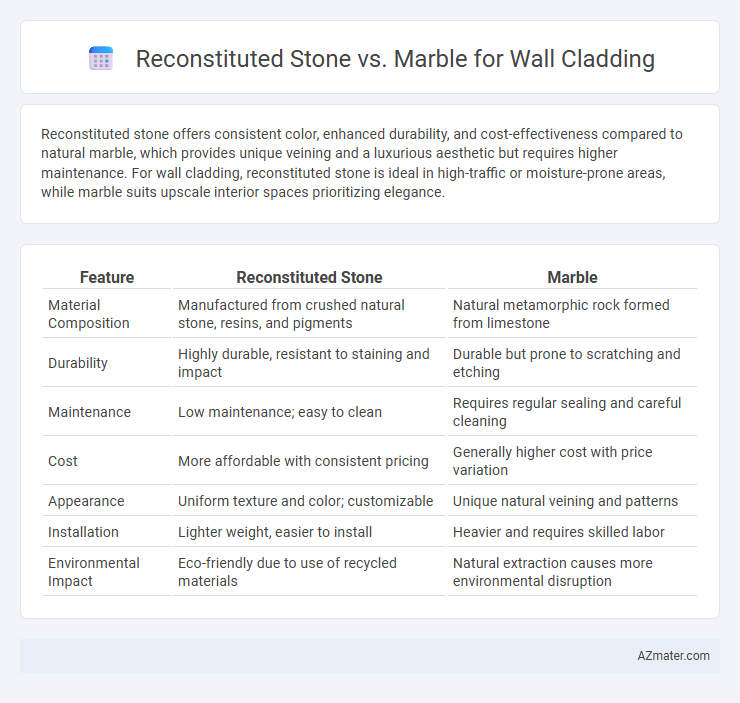Reconstituted stone offers consistent color, enhanced durability, and cost-effectiveness compared to natural marble, which provides unique veining and a luxurious aesthetic but requires higher maintenance. For wall cladding, reconstituted stone is ideal in high-traffic or moisture-prone areas, while marble suits upscale interior spaces prioritizing elegance.
Table of Comparison
| Feature | Reconstituted Stone | Marble |
|---|---|---|
| Material Composition | Manufactured from crushed natural stone, resins, and pigments | Natural metamorphic rock formed from limestone |
| Durability | Highly durable, resistant to staining and impact | Durable but prone to scratching and etching |
| Maintenance | Low maintenance; easy to clean | Requires regular sealing and careful cleaning |
| Cost | More affordable with consistent pricing | Generally higher cost with price variation |
| Appearance | Uniform texture and color; customizable | Unique natural veining and patterns |
| Installation | Lighter weight, easier to install | Heavier and requires skilled labor |
| Environmental Impact | Eco-friendly due to use of recycled materials | Natural extraction causes more environmental disruption |
Introduction to Wall Cladding Materials
Reconstituted stone offers a cost-effective and versatile alternative to natural marble for wall cladding, combining crushed stone aggregates with resins for enhanced durability and easier installation. Marble, renowned for its timeless elegance and unique veining, provides superior natural aesthetics but often requires higher maintenance and is more susceptible to staining and weathering. Both materials serve distinct functional and design purposes, with reconstituted stone favored for its uniform appearance and resilience, and marble for its luxurious, authentic look in architectural finishes.
What is Reconstituted Stone?
Reconstituted stone is a composite material made by mixing crushed natural stone, binders, and pigments, designed to replicate the appearance and texture of natural stone with enhanced durability and uniformity. Unlike marble, which is a natural metamorphic rock known for its unique veining and luxurious appeal, reconstituted stone offers a cost-effective, versatile, and sustainable alternative for wall cladding applications. It provides consistency in color and pattern, greater resistance to weathering, and easier maintenance compared to natural marble, making it ideal for both interior and exterior surfaces.
Understanding Natural Marble
Natural marble features a unique crystalline structure composed primarily of calcite, offering unmatched aesthetic appeal with its distinctive veining and color variations. Its high density and porosity influence durability and moisture absorption, critical factors in wall cladding performance compared to reconstituted stone. Understanding marble's natural formation and surface characteristics aids in evaluating its suitability for interior or exterior applications where weather resistance and structural integrity are paramount.
Aesthetic Differences: Reconstituted Stone vs Marble
Reconstituted stone offers a consistent pattern and color, allowing for uniform wall cladding with customizable designs that mimic natural stone textures. Marble provides unique, intricate veining and variations in color that create a luxurious and timeless aesthetic, adding depth and character to wall surfaces. While reconstituted stone can replicate marble's appearance at a lower cost, marble's natural beauty and distinctive patterns remain unmatched for high-end interior finishes.
Durability and Strength Comparison
Reconstituted stone for wall cladding offers superior durability due to its engineered composition, which resists cracking and weathering better than natural marble. Marble, while aesthetically appealing, is softer and more prone to chipping and erosion when exposed to harsh environmental conditions. The enhanced compressive strength and uniform density of reconstituted stone provide a longer-lasting, low-maintenance solution compared to the natural variability found in marble.
Cost Analysis: Reconstituted Stone vs Marble
Reconstituted stone offers a cost-effective alternative to marble for wall cladding, with prices typically 30-50% lower due to lower material and fabrication expenses. Marble, prized for its natural beauty and unique veining, incurs higher costs related to quarrying, transportation, and skilled craftsmanship. Maintenance and installation costs for marble often exceed those for reconstituted stone, impacting the overall budget for large-scale wall cladding projects.
Installation Process and Complexity
Reconstituted stone offers a streamlined installation process for wall cladding due to its uniform size, lighter weight, and pre-molded shapes, reducing labor time and complexity. Marble, being a natural stone with varying thicknesses and fragility, requires skilled labor for careful handling, precise fitting, and additional sealing to prevent damage during installation. The consistent quality and easier transportation of reconstituted stone make it a more cost-effective and less complex option compared to marble for wall cladding projects.
Maintenance and Care Requirements
Reconstituted stone for wall cladding offers low maintenance demands due to its engineered composition, resisting stains, scratches, and weathering better than natural marble. Marble requires regular sealing and vigilant cleaning to prevent etching, staining, and discoloration from moisture and acidic substances. Choosing reconstituted stone minimizes upkeep costs and extends surface durability in high-traffic or exposed environments compared to marble's higher sensitivity and care needs.
Environmental Impact and Sustainability
Reconstituted stone offers a more sustainable option for wall cladding as it is made from crushed natural stone combined with resin, minimizing quarrying impact and reducing waste. Marble extraction involves significant environmental disruption, including habitat destruction and high energy consumption during quarrying and processing. Reconstituted stone's production process typically results in lower carbon emissions and increased resource efficiency, making it a preferable choice for eco-conscious construction projects.
Choosing the Right Material for Your Wall Cladding
Reconstituted stone offers consistent color and texture with enhanced durability, ideal for modern wall cladding projects requiring uniform appearance and resistance to weathering. Marble provides natural elegance and unique veining patterns, making it a preferred choice for high-end, aesthetic-focused interiors but requires more maintenance due to its susceptibility to staining and weather damage. Selecting the right material depends on balancing budget, desired look, durability needs, and maintenance capacity for long-lasting wall cladding results.

Infographic: Reconstituted stone vs Marble for Wall cladding
 azmater.com
azmater.com